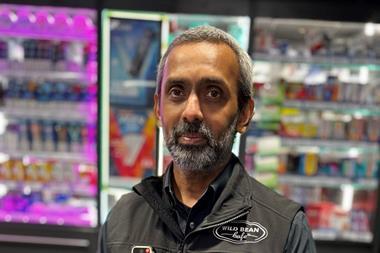They take up little counter space, are sale or return and offer 20% margins. The collectibles market is anything but just a passing fad.
Ah, the good old days. Running down neighbourhood streets, scoring tin-canned goals through jumpers-for-goalposts, Top Trumps and Rubik’s Cubes. Ask anyone over 40 about their childhood and they’ll picture something bordering on the sepia-tinted Hovis bike ad, while lamenting the current generation of obese, freak-thumbed, pasty children whose only interaction with each other is smart-mouthed insults through the Xbox. If it isn’t in digital format, they’re not interested, right?
Try telling that to Panini head of circulation Rebecca Smith, who is predicting £40m-worth of sales from its official FIFA World Cup stickers alone, boosting the total collectibles category to £80m this year - up from an average of £60m per year. “It’s a massive market; I think people underestimate just how big the market is, and especially this being a World Cup year.”
When you look at the mechanics of the market, it’s not difficult to see why it generates such sales. Take Topps’ brand Match Attax, a trading card game whereby cards can be used on their own to select a best team, or played in a card game using defence and attack statistics on the cards. Packs are sold in 10s for £1, but there are 420 different players to collect. It doesn’t take a maths genius to tot up the potential.
“These cards offer good margins of 20-25% and there is no effort needed and no risk because it’s sale or return”
Anjali Karpal, Essential Convenience Store, Horsham, West Sussex
It was declining magazine sales which first brought News of the Wharf stores owner Peter Wagg and his operations manager Paul Donegan to the category. Peter owns six CTNs on the Canary Wharf estate in London and one convenience store on East India Dock. According to Paul, this time two years ago they wouldn’t have given the category the time of day: “We used to return any to the magazine wholesalers when they sent them through.” However, when looking at ways to attract customers back to magazines they decided to give the collectibles market a try.
Paul says customers often asked for football cards so they began to stock Match Attax, then widened it to collections such as Peppa Pig and other football cards.
“The sales were good,” says Paul, who points out that with space at a premium they wouldn’t waste their time stocking something that wasn’t doing well.
The stores now have an agreement with Panini for preferential placement, but continue to stock Match Attax. As Canary Wharf doesn’t allow retailers to have posters in the windows without prior agreement, advertising is done on digital media screens and a freestanding display unit.
He says that he listens to customers about which collections they should stock. “We have a lot of interaction with our customers, and use social media a lot. They tell us what they want to see and if we can get it, we do.”
According to Smith, while the supermarkets have suddenly woken up to the profit potential of collectibles, it is c-stores which remain the heartland for these type of products. Topps marketing director Rod Pearson agrees, saying that convenience stores and smaller groups account for about 64% of Topps’ sales.
Even in years where there isn’t a big football tournament, the collectibles market can be hugely profitable for retailers, particularly those who sell magazines. Smith says that children’s magazines and the collectibles market are now so intertwined that half the work is done for the retailer. “A lot of the properties are already established with magazines. As soon as you get the magazine with a covermount into children’s hands, the job is done for you.”
Pearson agrees: “If you present the products clearly and put other children’s products with it you’ll get good sales,” he says. He claims that the target market for the company’s Match Attax products are boys aged 6-12, and that one in 2.6 kids collects Match Attax products.
Paul’s weekday customers tend to be high-earning city workers who often buy for their kids, and sometimes for themselves. “I think sticker collections have quite a retro feel. I can still recall my 1986 collection.”
“There are a huge amount of second generations who collect,” agrees Panini’s Smith. She says that as well as sport, these collectors are often into collections such as Star Wars and Dr Who. Pearson says that 64% of Topps’ purchasers are adults - either buying for children or themselves.
Horsham retailer Anjali Karpal, who stocks Match Attax in her West Sussex Essential Convenience Store, says the category sells itself. “Even though we’ve got a WH Smith in competition up the road and the packs of cards are £1, we still see children come in with a tenner and get 10-packs. They’re swapping them in the playground and playing the games.” She says that she finds the football market the most popular with occasional girl-focused collections doing well. “These cards offer really good margins of 20-25% and there is no effort needed and no risk because it’s sale or return.”
One of the best things about the category is the massive amount of marketing that is often put behind the collections. For instance, for the World Cup, Panini is giving away free albums in newspapers; one for every child who wants to collect, says Smith. A major TV campaign to highlight the collection is already running. But don’t leave it too late. According to Smith, 70-80% of sales of World Cup collectibles are predicted to take place in the 12-week run-up to the tournament, so retailers need to be stocking up now.
With high margins and sale or return on goods, why isn’t every retailer getting behind the category? According to National Federation of Retail Newsagents news controller Brian Murphy, fear of theft and a lack of space could be putting some store owners off. He says retailers may also have had bad experiences in the past. “Retailers have previously lost credit through not returning them on time so have had their fingers burned.” Confusion is also responsible for some retailers’ reticence: “They wrongly believe they have to keep them and cannot early return, and that they have to stock every collectible - but you can pick and choose!”
Managing director at product distributor Innzone, Philip Glynn, says that retailers can’t afford to pass up the opportunity: “If it’s risk free what’s the problem? You should always accept a product because you can always be surprised.”
Anjali agrees that stocking collectables is a no-brainer, claiming that once kids know that you stock a particular collectible they fly out the door. “You have to let customers know what you’ve got - put the posters up that come with the collections,” she says. “I think every shop should do it.”
Making the category pay
Fads come and go - keep a close eye on what’s doing well and don’t hold onto products no longer selling
Don’t miss return dates - it can be costly if it results in lost credits
With up to 80% of World Cup collectible sales happening before the tournament starts, you should be stocking up now
Think about introducing a reward or loyalty scheme for the category
Use the marketing which accompanies boxes and promote the best-sellers in store and in your window
Watch out for marketing from the companies: Panini started giving away albums in the national press at the beginning of the month
Cross-merchandise with the supporting magazines
Don’t forget to tell your customers you stock collectibles - and remember it’s not only kids who buy them, adults buy them for their kids (as well as themselves)
Trends
How to predict the next big hit
Predicting what’s going to be all the rage among 10-year-olds can be tricky, which is why retailers should leave it up to the distributors, says Innzone’s Philip Glynn. “They have to take enormous risks because they have to get in early, so let them take them. As the product is sale or return you’re not taking risks.”
He says that retailers will be able to tell within a couple of weeks what is working. “Once it gets into the playground and kids start to swap and trade, it takes off. But if it doesn’t work then move on.”
Panini’s Rebecca Smith agrees: “It’s hard predicting trends so you look to the publishers and distributors.” Panini launches between 20 and 25 collections a year, but backs them with marketing campaigns such as vouchers for free starter packs in newspapers. “As soon as that happens the sales start.”
Topps’ Pearson says that retailers need to realise that companies such as Topps spend a lot of time and money researching upcoming trends. “It’s in our interest not to make mistakes so we test them with focus groups. We take a lot of time before putting lines out to market.”
He says that while football is the ‘evergreen’ product, other fads fade in and out of popularity. “A few years ago it was High School Musical, then Moshi Monsters. The TV and film franchises are more transient, but can be very profitable,” he explains.
According to Smith, the pre-school market tends to be steadier and less gender-specific. “Something like Peppa Pig always does very well and doesn’t tend to peak around certain times, and can still be selling up to a year.”
Other steady sellers include stalwarts such as the Teenage Mutant Ninja Turtles and pop groups such as One Direction. Retailers can cross-check new launches with magazine sales of those characters to see if there’s an established interest in their area.
“Retailers clearly need to be savvy about what’s hot and what’s not,” says Pearson, “but when it comes to things that seem to just come out of nowhere, the kids will probably be asking for them. As soon as that happens they should stock them.”





















No comments yet